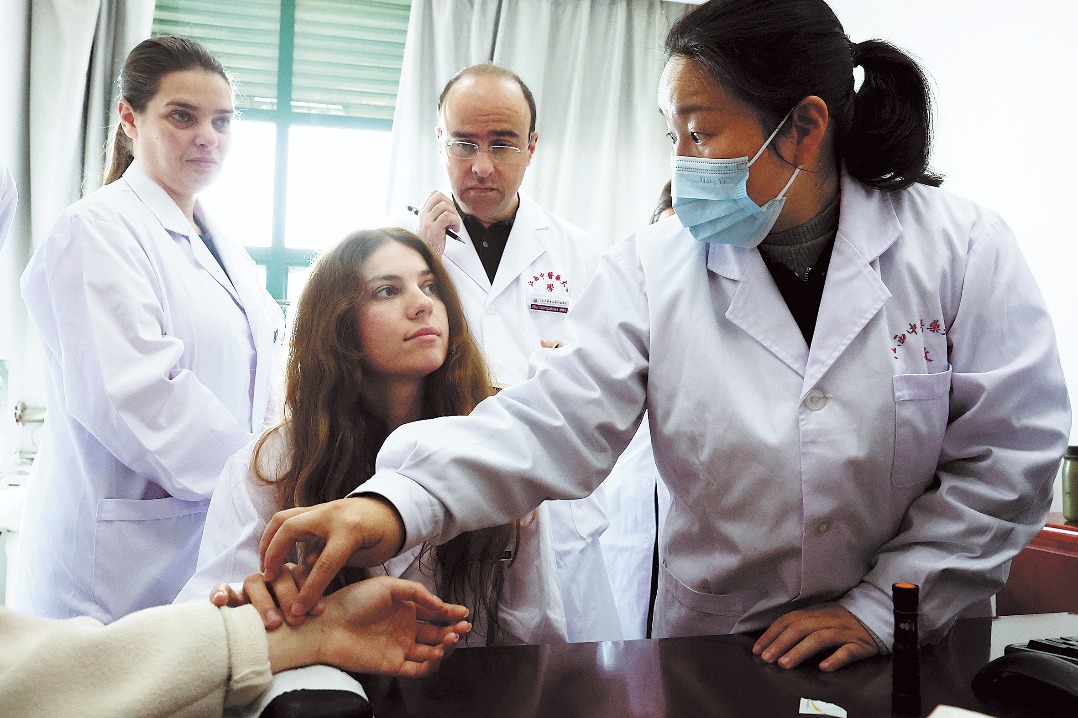Women in science can change world

From climate change to the energy crisis, to COVID-19, the answers to our most universal challenges lie in science. Yet in seeking them, we still exclude the brainpower of half the world — women and girls.
Just 28 percent of engineering graduates, one-third of scientific researchers worldwide and three percent of Nobel laureates are women. At the Chinese Academy of Sciences and Chinese Academy of Engineering, only seven percent of academicians are women. Such imbalances not only risk replicating gender biases and inequalities in new technologies, but also lead to expertise and talent shortages across science, technology, engineering and mathematics, or STEM, globally that society can ill afford. For a future that truly includes everyone, women and girls must be able to participate in science fully and equally.
When they do, the rewards are high. Take Tu Youyou, the first Chinese Nobel laureate in Physiology or Medicine in 2015, decades after discovering the malaria treatment, artemisinin. "Every scientist dreams of doing something that can help the world," she said. When more women become scientists, more people become able to do so.
This is clear in China, where over half of all patent applicants are now women. Women also build more than half of the country's internet companies, like Zhou Qunfei, a migrant worker who later founded touchscreen manufacturer Lens Technology, becoming one of the wealthiest women in technology.
Yet despite making invaluable STEM contributions in China and beyond, women risk being left behind in the fourth industrial revolution. An estimated 80 percent of high-paid jobs created in new green economy sectors, including clean energy, will be in STEM fields dominated by men. This means women and girls could be overlooked and underrepresented in future technologies — unless they are supported in STEM today.
With just eight years to realize the Sustainable Development Goals and a peaceful, prosperous future for all that our planet can sustain, expanding our pool of innovators and experts, by including women fully, is more urgent than ever.
Four steps are vital to achieve this. First, gender stereotypes and biases holding women and girls back in science must be changed. Microsoft reported that girls in Europe become interested in STEM around the age of 11, but lose interest by 15, suggesting social influences redirect them. Women are also underrepresented in STEM leadership, as well as less likely to be recruited, despite being qualified.
Thirty-two percent of Chinese women scientists encountered employers who only sought out men during their first job searches, according to the journal Nature. To fix this, gender quotas should be applied at all levels to safeguard against discriminatory hiring practices. Gender equality education should also be strengthened, from classrooms to corporations, while a supportive environment for women and girls must be created within families and by employers, to encourage more empowering norms.
Second, removing structural inequalities in scientific fields is essential. Female researchers tend to be awarded less funding, have fewer resources and opportunities, while leaving careers earlier than their male colleagues. Globally, more than one-third of women left full-time STEM careers after their first child. This also happens in China — but three-quarters of those who left said they would return, if sufficient childcare was available. So along with supporting women and girls entering STEM, an inclusive environment is needed to retain them. Research institutions, employers, governments and all stakeholders must increase family-friendly policies and investments, including childcare facilities and services, paternity leave and flexible working arrangements.
While structural changes take time, special measures for women offer more immediate solutions. For example, given that raising children requires extended leave — a responsibility falling disproportionately on women — allowing female researchers longer time to secure funding can help. In 2011, the National Natural Science Foundation of China lifted its grant age limit for women from 35 to 40, boosting the percentage of women winning grants from a major fund for young scientists from 33 percent to 43 percent in one year. Along with the Ministry of Science and Technology, the foundation also raised the number of female scientists on review panels and recommended female applicants be prioritized, when all else was equal.
Third, unpaid care and domestic work has forced women to quit or slow their careers. Among married women scientists surveyed by Nature, 30 percent reported doing most housework, versus only six percent of men. The pandemic has deepened this divide. Comparative data for 2019 and 2020 suggest women scientists as primary caregivers for children experienced a 17 percent decline in research time. Female academics are posting fewer preprints and starting fewer projects than their male peers. Instead of freeriding on women's unpaid work, society should collectively assume the costs, by recasting public spending on care as a social investment. Care and domestic work deserves recognition. It must also be redistributed between men and women.
Increased paternity leave is one way to encourage this. For example, the proportion of men taking paternity leave increased from 4 percent to 39 percent when Norway introduced 4 weeks of full payment paternity leave in 1993 and further increased to 89 percent as Norway gradually extended paternity leave entitlements to now 15 weeks. In China, there are no regulations or legislation at the central level regarding paternity leave, and while in some provinces, men are entitled to as many as 30 days of paternity leave, more will need to be done to rebalance the burden of care.
Finally, outstanding women scientists must be promoted as role models and mentor younger women. Research reveals that women without mentors report the lowest career optimism. Women and girls should be supported early on to take an interest in science and be guided in their careers.
Equality in STEM would enable faster scientific advances and a more inclusive world. It also makes business sense: organizations with gender-diverse executive boards outperform financially by 25 percent, according to the consultancy company McKinsey. Achieving equality not only benefits everyone, but also depends on everyone — parents, spouses, institutions, employers and universities. That is why the United Nations Development Programme, UN Women and the entire UN system partner with all involved to elevate women in STEM.
History shows the incredible leaps humanity makes when women step forward in science — from Marie Curie, to Tu youyou. Such potential likely exists in countless woman and girls today, if they find the encouragement, resources and enabling environment to go forward. Unlocking this is about more than realizing gender equality; it is also about what equality can realize for us all.
Beate Trankmann is UNDP resident representative in China; and Smriti Aryal is UN Women country representative in China.
The views don't necessarily reflect those of China Daily.

Today's Top News
- China releases white paper on arms control in new era
- Japan must fix stance on Taiwan question
- Anti-fraud effort defends public's property, dignity
- Drive to spur SMEs gains momentum
- Huge blaze engulfs residential area in Hong Kong
- Hong Kong residential area fire gradually brought under control: HKSAR chief executive





























